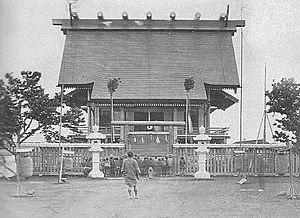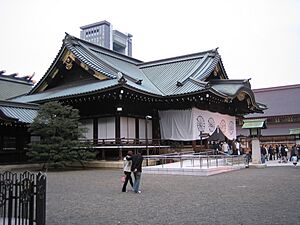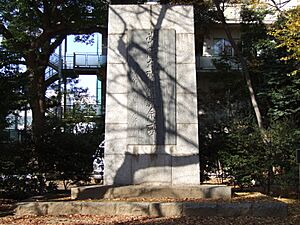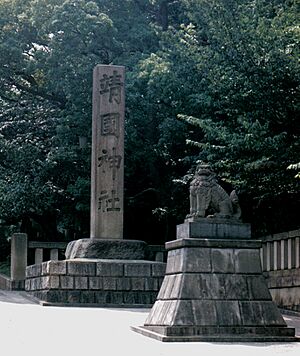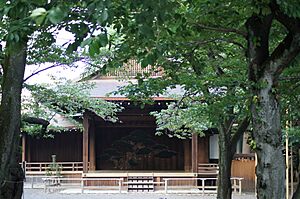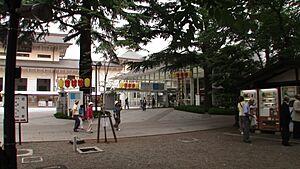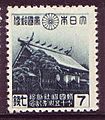Yasukuni Shrine facts for kids
Quick facts for kids Yasukuni Shrine |
|
|---|---|
|
靖国神社
Yasukuni Jinja |
|
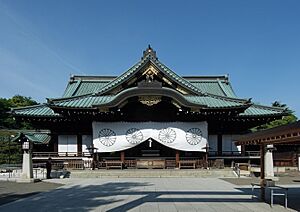
The haiden (hall of worship)
|
|
| Religion | |
| Affiliation | Shinto |
| Festival | |
| Type | Chokusaisha (former bekkaku-kanpeisha) |
| Location | |
| Location | 3-1-1 Kudankita, Chiyoda, Tokyo 102-8246 |
| Lua error in Module:Location_map at line 416: Malformed coordinates value. | |
| Architecture | |
| Architectural style | Shinmei-zukuri, copper roofing (dōbanbuki) |
| Founder | Emperor Meiji |
| Date established | June 1869 |
Yasukuni Shrine (靖国神社 or 靖國神社, Yasukuni Jinja, lit. Peaceful Country Shrine) is a special Shinto shrine located in Chiyoda, Tokyo, Japan. It was started by Emperor Meiji in June 1869. The shrine honors people who died serving Japan in wars. This includes conflicts from the Boshin War (1868–1869) to the Second Sino-Japanese War (1937–1945).
Over time, the shrine's purpose grew. It now includes those who died in many wars involving Japan. These wars happened during the Meiji period, Taishō period, and early Shōwa period. The shrine keeps a list of 2,466,532 people. It records their names, where they came from, when they were born, and where they died.
Contents
History of Yasukuni Shrine
How the Shrine Began
The place for Yasukuni Shrine was chosen by Emperor Meiji. It was first called Tōkyō Shōkonsha (東京招魂社, "shrine to summon the souls"). The shrine was built in 1869, right after the Boshin War. Its goal was to honor the souls of those who died fighting for the Emperor.
At first, it was the most important shrine of its kind in Japan. Many smaller shrines across the country also honored local people who died serving the Emperor. After the 1877 Satsuma Rebellion, the Emperor had 6,959 more war dead honored here. In 1879, the shrine's name was changed to Yasukuni Jinja. The name Yasukuni means "Pacifying the Nation." Emperor Meiji chose this name.
Some famous people honored here include Yoshida Shōin and Sakamoto Ryōma. They helped overthrow the old government and start the Meiji Restoration. However, people who fought against the Meiji government were not honored here. For example, Saigō Takamori was not enshrined because he later rebelled.
From Early Wars to World War II
In 1887, the military took control of honoring the war dead at Yasukuni. As Japan grew, people from different groups were honored. This included Okinawans, Ainu, and Koreans. Later, Taiwanese people were also honored, especially during World War II.
In the 1930s, the military government made Yasukuni Shrine even more important. It became a central place to remember those who died in war. Honoring someone at Yasukuni meant they were seen as a national hero. This helped keep up spirits during the war.
After World War II
After World War II, the American-led forces (GHQ) took over Japan. They made a rule called the Shinto Directive. This rule separated religion from the government. Yasukuni Shrine had to choose to be either a government place or a private religious place.
In 1946, Yasukuni Shrine became a private religious organization. The GHQ had thought about destroying the shrine. But some religious leaders argued that honoring war dead is important for all people. So, the GHQ decided not to destroy it.
Exploring the Shrine Grounds
The shrine grounds cover a large area, about 6.25 hectares. There are many buildings and structures here. Yasukuni is special because of its recent history. The Yūshūkan museum is one unique feature.
Main Shrine Buildings
The haiden is the main prayer hall. Visitors come here to pray and make offerings. It was first built in 1901. Its roof was fixed in 1989. For special events, the white screens inside are changed to purple.
The honden is the most sacred part of the shrine. This is where the spirits honored at Yasukuni Shrine live. It was built in 1872. Only the shrine's priests go inside to perform Shinto rituals. It is usually closed to the public.
The Sanshuden (参集殿) (Assembly Hall) is next to the haiden. It was rebuilt in 2004. It has rooms for people and groups who want to worship.
Behind the honden is the Reijibo Hōanden (霊璽簿奉安殿). This building holds the Symbolic Registry of Divinities (霊璽簿, Reijibo). This is a handmade paper document with the names of all the spirits honored at Yasukuni Shrine. Emperor Shōwa helped pay for it in 1972.
There are also two smaller shrines on the grounds. The Motomiya (元宮) is a small shrine that was moved here in 1931. It was like an early version of Yasukuni Shrine. The Chinreisha was built in 1965. It honors people who died in wars or incidents around the world, no matter their nationality.
Gates and Entrances
There are several torii gates and other entrances at the shrine.
- The Daiichi Torii (Ōtorii) is the first and largest gate visitors see. It is a huge steel structure, about 25 meters tall. It was first put up in 1921. The current one was built in 1974.
- The Daini Torii is the second gate. It is the largest bronze torii in Japan. It was built in 1887.
- After the Daini Torii is the shinmon (神門). This is a tall gate made of cypress wood. It has two doors with large Chrysanthemum Crests.
- The Chumon Torii (中門鳥居) is the last gate before the haiden. It was rebuilt in 2006.
Other gates include the Ishi Torii, a large stone gate. The Kitamon (North gate) and Minamimon (South gate) are other entrances to the shrine.
Memorials and Statues
Many memorials and statues are found on the shrine grounds:
- Irei no Izumi (Soul-Comforting Spring): This spring honors those who died from thirst in battle.
- Statue of War Widow with Children: This statue honors mothers who raised children after their fathers died in war.
- Statue of Kamikaze Pilot: A bronze statue of a kamikaze pilot. A plaque lists the 5,843 men who died in suicide attacks during World War II.
- Statue of Ōmura Masujirō: This is Japan's first Western-style bronze statue. It honors Ōmura Masujirō, known as the "Father of the Modern Japanese Army."
- Monument of Justice Radha Binod Pal: This monument honors an Indian judge. He was the only judge at the trials of Japanese war crimes after World War II who found all defendants not guilty.
- Statues honoring animals in war: There are three life-sized bronze statues. One honors horses used by the military (1958). Another honors homing pigeons (1982). The last one honors military dogs (1992).
-
Monument of Justice Radha Binod Pal
- Hitachimaru Junnan Kinenhi (常陸丸殉難記念碑) (Monument for the dead in Hitachi Maru Incident)
- Gunjin Chokuyu no Hi (軍人勅諭の碑) (Monument of Imperial Rescript to Soldiers and Sailors, an ethics code for soldiers and sailors)
Other Interesting Places
- Syagō Hyō (社号標) (Stone pillar with the shrine name)
- Dovecote: Almost 300 white doves live here.
- Nōgakudo (Noh Theater): This theater was moved to Yasukuni Shrine in 1903. Traditional Japanese plays and dances are performed here.
- Yūshūkan: This museum was built in 1882. It shows relics and weapons from Japan's military history. It has a Zero Fighter plane and a Kaiten suicide torpedo. The museum's way of showing history, especially from 1931 to 1945, has caused some debate.
- Shinchi Teien (神池庭園): This is a Japanese garden with a small waterfall and pond.
- Sumo Ring (Sumōjō (相撲場)): Sumo wrestling shows are held here almost every year during the Spring Festival. Many professional sumo wrestlers, including champions, take part. The matches are free.
Images for kids
See also
 In Spanish: Santuario Yasukuni para niños
In Spanish: Santuario Yasukuni para niños


